What is the best bandsaw for resawing in 2021 and 2020?
Buying the right bandsaw can change your woodworking experience and results. The main component of their success is their versatility compared to other saws. For example, do you want to cut a piece of a circle in plywood? Well, a bandsaw is the best tool for the job. Grizzly wood? It is simply to use a larger cutting top.
Bandsaws are one of the coolest tools on the market. A large advantage they have is:
- They are far safer than table saws, especially if you are going to resaw.
- They are simple to use and are one of the most versatile work saws.
- They have a high resaw capacity.
Table of Contents
- 1 Our Picks for the Best Band Saw for Resawing
- 2 JET JWBS -14 DXPRO Resawing Band Saw
- 3 SKIL 3386-01 Bandsaw - Best for the Money
- 4 Delta 28-400 14in. Steel Frame Bandsaw
- 5 WEN 3962 Two-Speed Resawing Bandsaw
- 6 Grizzly G0555LX Saw - Top Pick
- 6.1 WEN 3962 Two-Speed Resawing Bandsaw – Most Affordable Budget Option
- 6.2 SKIL 3386-01 Bandsaw For Re-sawing Review ( Our Top rated Small Bandsaw)
- 6.3 Powermatic PWBS – 14CS Resawing Bandsaw
- 6.4 Laguna Tools MBAND1412-175 14 x 12 Bandsaw For Resawing
- 6.5 Delta 28-400 14 in. Steel Frame Resawing Band saw – Top Pick
- 6.6 RIKON Power Tools 10-324 14 inches Open Stand Resaw Bandsaw
- 6.7 JET JWBS 14-DXPRO 14-inch Bandsaw For Resawing
- 7 Buyer’s Guide: Choosing the Best Bandsaw For Resawing
- 8 Tips for Bandsaw Re-sawing
- 9 Our pick for the Best Bandsaw for Resawing?
Our Picks for the Best Band Saw for Resawing
Product | Product Details |
|---|---|
OUR #3 RATED Delta 28-400 14in. Steel Frame Bandsaw | |
OUR #4 RATED WEN 3962 Two-Speed Resawing Bandsaw | |
OUR #5 RATED Grizzly G0555LX Saw - Top Pick |
What is the best band saw for resawing and what is the best budget bandsaw? Let us give you a quick list of the products that will have reviews in this article:
WEN 3962 Two-Speed Resawing Bandsaw – Most Affordable Budget Option
From our reviews, this is our top recommendation for fine woodworking. This is one of the few 10 inch band saws we reviewed. Of all of the saws I did reviews for this was my favorite. We use it all the time and it perfectly handles the resawing of all our woodworking without any issue. If you seek a budget, performance worthy option, then you shouldn’t look any further than the WEN machine. It has a bunch of options, and it comes at just under $300 (as at January 26, 2019), it is hard to find any that beats this excellent saw as the best value for the money. It comes in three sizes: 9 inches, 10 inches, and 14 inches.
All in all, it is a perfect blend of both quality and price. This machine’s saw table features a left tilt to 45 degrees, and it can cut at two speeds for the blade speed – 1520 and 2620 fpm.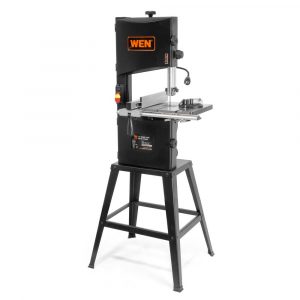
Its 3.5 amp motor provides plenty of power for most cuts of material, and these include even the most demanding ones, which, is really a surprise for a saw of its size and price. If you need the perfect band saw then you have the right model to resaw for you. This is first on our list because it is the best one for resawing.
This is an excellent budget band saw, and it comes in at 10 inches. This sometimes makes it feel underpowered, but with unbeatable blade speed and a sturdy body, it is hard to beat.
Amazon
SKIL 3386-01 Bandsaw For Re-sawing Review ( Our Top rated Small Bandsaw)
This is a band saw that comes complete with a one-speed motor that is both strong and speedy when using it for a resaw. It is easy enough to use, but durable enough to cut through plastic, metal, and boards. It also has a rack and a pinion table adjustment option that allows for height and angle adjustments.
Amazon
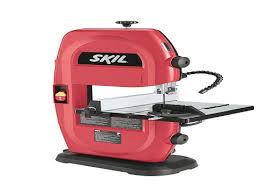
The SKIL 3386-01 resaw bandsaw is a stationary band saw that has a rip fence that ensures that you have an accurate cut, and that your bandsaw blade will stay straight. A woodworker and metal cutter depend on the rip fence or the metal bar that is parallel to the bandsaw blade that ensures a straight and non-crooked cut every time you cut.
This machine’s power tool comes with a powerful motor, handle, rack, pinion adjustment, and the needed LED work light.
With this simple tool, sawdust or metal shavings will certainly not be a problem for the right stationary bandsaw’s one half inch dust port. Not only does it give excellent resaw, whatever little particles that you might have gathered from cutting excess wood or metal can be sucked up easily with a vacuum, and this is made possible because of the attached dust port.
Once you start using this product, its effectiveness is very noticeable. It enables you to not only cut faster, but it also allows you to cut materials into pieces that are smaller and thicker than what the regular table would accomplish.
In addition to all this, your resaw is very visible, and this is thanks to the design of the band saw, giving way for fewer second guesses.
- Grizzly G0555LX Deluxe Resawing Bandsaw
While this might not be the best bandsaw for resawing, this good bandsaw was a great contender for the right pick bandsaw for 2018. It is lightweight, weighing 247 lbs, and for its cheap price it does a good job of resawing. It is also a lot lighter.
Despite being less money, this machine is a great machine that delivers.
The Grizzly G0555LX offers a rugged and thick cast iron frame that provides enough support to make exact cuts. It is powered by a 1 hp motor and two speed options 1800 or 3100 fpm, and it makes effortless cuts.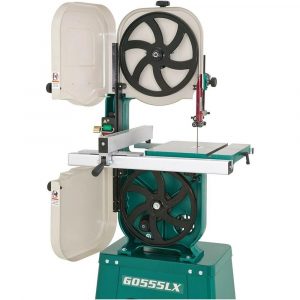
One of the most unique features of this saw is its computer balanced wheels. The wheels are coated in rubber and are balanced via computer. The fence is sturdy aluminum construction and has a built-in magnifying window and a miter gauge for ease of adjustment.
Its new wheels make for an incredibly quiet band saw, delivering very accurate wood cuts as compared to other cuts. Although, this band saw, overall, is a great machine, the same cannot be said for its instruction manual which seems complex and very hard to comprehend.
While we always welcome a solid sturdy saw for resawing, the Grizzly seems a bit heavy to carry around.
Powermatic PWBS – 14CS Resawing Bandsaw
I spent quite a bit of time reviewing this saw. This is another very close competitor for our top pick. It has a 1 ½ horsepower motor, combined with a poly V Belt Drive system, and with a sturdy cast iron table that creates an awesome cutting machine.
This is a heavy-duty saw and it gives a tremendous amount of saw for its price.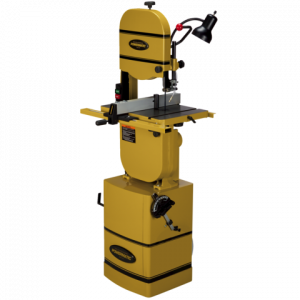
Both the 15 x 15 inch saw table and its wheels are made from cast iron. You wouldn’t need any converters in your tool shop; the saw can be directly plugged to a 110v AC. The dust collection is well taken care of. Its lower part has a 4-inch port, and this does a great job of eliminating the dust.
Just above the table, there’s a chip blower and a pressurized nozzle, meaning that you can keep the work area clean with less debris. Its induction motor means that it is one of the quiet machines in our pick. Its motor is backed up by a welded steel frame that significantly reduces vibrations.
This band saw is lightweight as compared to the other ones on this list. It weighs 280 lbs.
Although it is sturdy, its light weight can seem a bit uncomfortable when handling larger, longer wood.
Laguna Tools MBAND1412-175 14 x 12 Bandsaw For Resawing
This is another one of the best bandsaw for resawing and worth your time to investigate. This bandsaw is powered by a monster 1 ¾ horsepower motor that will be more than you ever need. The power is combined with some great features like a 12-inch resaw capacity.
The manufacturers, when designing this, had re-sawing in mind. Its fence has two settings: low and high. These allow you to support long and thick boards when resawing and saves time.
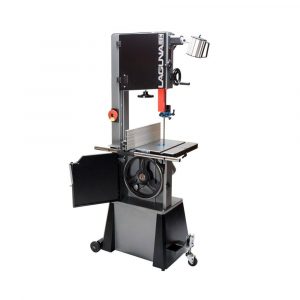
The heaviest lumber is supported by a solid cast iron table and a steel frame with a pyramid spine for some extra strength. For other cut types, it is flexible, with a table that tilts 7 degrees to the left, and 45 degrees to the right.
It has a tracking window, a safety key, and a two-year warranty.
You can use bandsaw blades ranging from 1/8 to ¾ of an inch long which can be disappointing. If this band saw had the to ability to take slightly wider blade, it would be a contender for the top pick.
Delta 28-400 14 in. Steel Frame Resawing Band saw – Top Pick
This machine has a large table for working (making work very convenient) on, and it has been said that it has a European feel to it. It weighs about 160 pounds, and it is made of steel, reducing the flexing and aluminum trunnion table support.
Its table support ensures this machine lasts for a very long time to use for resawing. This machine gives a very good finishing both on the inside and out. Some users have reported some bit of difficulty when constructing the bandsaw; but in all, the machine has a very good rating score among users.
All the parts of this machine fit well together, and only the best materials are used. Its dust and debris collecting ability is very impressive. You do not have to worry about a huge amount of dust cluttering your workspace. The table has small holes that help to collect the dust and keep it off your table.
Must Read: Best Concrete Saw
And with these small holes over 90 percent of the dust is collected and removed from the workspace. When using this bandsaw, you can expect a clean environment to resaw. Additionally, you can find a convenient power switch that comes with a lock key.
The sound that this machine emits while resawing wood is very little. You will enjoy working with this machine as the noise and vibration that it generates is very minimal, preventing distractions and frustrations for you and those in your workshop.
To show just how minimal the sound of this machine is, you will be able to even talk to your coworkers while it is in use, without you having to talk at the top of your voice.
RIKON Power Tools 10-324 14 inches Open Stand Resaw Bandsaw
RIKON Power Tools are best known for their quality products, and this particular product delivers on many fronts. This isn’t our pick for the best bandsaw for resawing but it is a great option. It is equipped with a 1 ½ motor and balanced aluminum wheels, it gives plenty of power for most cuts in wood.
This machine has a dual voltage, so it is comfortable to keep in a shop with 220v or 110v. You can adjust the depth of your cut simply with a rack and pinion system that are seen in a bandsaw for the very first time.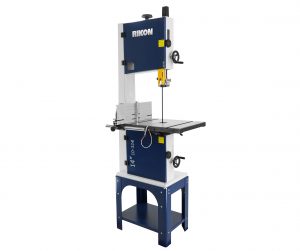
Fence
When it comes to re-sawing, the rip fence comes into its own. The 6-inch high fence can support the most substantial pieces of wood with no problems whatsoever.
The tall fence has slots that are milled in it so that you are able to fix auxiliary fence with ease. You can almost re-saw anything with its 13-inch long resaw capacity. Another very new feature of the saw is the ball bearing at both the upper and bottom part of the saw. These ball bearings allow the blade to travel with less friction.
The reduction in friction means that the blade will last longer due to the reduced heat load on the blade itself. This saw is lighter than some of the reviewed saws, weighing 218 lbs. Despite this, the steel frame construction and cast iron saw table make it a sturdy, rugged band saws for resawing.
With these fresh inventions, it brings in new challenges for setup. Sadly, it is only available in metric. So, you will have to use aftermarket materials in order to give some alterations.
JET JWBS 14-DXPRO 14-inch Bandsaw For Resawing
This revamped model does have all the features you would look for in a bandsaw for resawing: a fantastic performance from a machine that feels and looks incredibly well made. Everything from the blade to the wheels looks incredible.
This new model has a redesigned frame that gives excellent support. Its ¼ inch motor combined with a V-Belt Drive and a large 15 x 15 inch long cast iron table means that this saw can handle just about any cut of wood that comes through its blade.
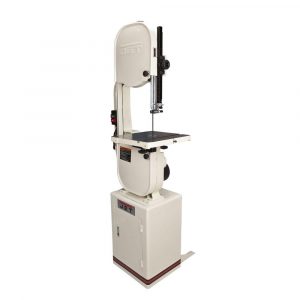
It has two speeds that makes short work of most wood cuts, slower speeds move through thicker pieces when re-sawing. Higher speeds during a resaw create a cleaner, more accurate cut when working with thinner stock.
This machine is a heavyweight machine that weighs close to 285 lbs. For this amount of money, you will get a great machine, a bandsaw that is well made. This bandsaw can deliver on many fronts including a 12-inch resaw capacity, as well as a new top for the best resaw.
It has a modern design, which can make it a little complicated to use for resawing. Although, as you use it, you will learn all its capabilities.
JET JWBS 14DXPRO 14-inch Bandsaw is one of the best and you really can’t go wrong with any resaw. It is one great saw. If you are in search of a top option on the market, this should be your choice.
It has a remarkable cutting capability and resaw capacity, and it comes with great accessories, they are all in a sturdy solid machine that makes it the best machine in 2020.
Buyer’s Guide: Choosing the Best Bandsaw For Resawing
There are a few things you need to consider when picking a bandsaw for resawing and listed below are some of these important things to note.
Power
Along with its blade, the power of your bandsaw’s motor plays a vital role on its effectiveness for resawing. There are lots of products available on the market with motors in the one horsepower range or even less and it is not worth the money.
Although this is sufficient for most cuts of wood, they usually come short when it comes to re-sawing. When re-sawing, one tends to be cutting a wood board across its widest point.
Doing this, you would need more power than your typical bandsaw will offer for resawing. When it comes to the motors of bandsaws, the more the better. Look for a bandsaw with a minimum of a 1 horsepower.
There are lots of saws on the market that offer the 1 ¼ , 1 ½ and 2 horsepower motors. For the 14-inch bandsaws, sufficient power is needed. If you get anything less than 1 horsepower for a 14-inch bandsaw, you will struggle to drive the blade through a thick board.
Throat Resaw Capacity
The bandsaw’s throat resaw capacity is the size distance between the top blade guides and the saw table. Other smaller saws come with a limited throat resaw capacity of 4 to 5 inches. Such a small throat is not sufficient for re-sawing purposes.
In order for you to create beautiful book-matched cuts, you would need a minimum capacity of 8 inches or more. And just like the horsepower, the more the merrier in relation to the throat capacity. Most of the featured saws in this article can cut a 10-inch wide board with ease.
Guide Wheels-Aluminum vs. Steel
Another one of the factors that affects a saw’s performance is the material of the bandsaw’s wheels that drive the blade. The heavier the wheel that is driving the table, and the more dullness and momentum that is behind the table, the easier it would cut.
You should think of it like catching a tennis ball or a baseball that is thrown at the same speed with your bare hands.
Although both balls are moving at the same speed, the increased weight and heaviness of the baseball will make it have a more significant impact.
Bandsaw wheels are usually either aluminum or cast iron. Aluminum, though, is far lighter, and they can be found in cheaper saws. Cast iron wheels are way heavier and are found in higher quality machines. And this makes the cast iron wheels the best choice to go for when choosing a bandsaw.
Variable Speed
The ability to modulate the cutting speed of your bandsaw is a great thing when re-sawing. Slower cutting speeds are usually preferred when re-sawing. The reduced speed usually creates a slow and steady cut.
This type of cutting prevents the saw from binding, while it removes a lot of material with each pass during resawing.
For more complex cuts, you can always switch back to higher speeds for a more cleaner, faster and accurate cuts of wood.
Blade Guides
These are there to make sure that your blade stays true, square to the table, and prevents it from turning. The guides serve as rollers that may sit on either side of the blade, keeping its movement straight and true during a resaw.
There is also a thrust support which presses against the back of the bandsaw blade. The thrust support prevents the blade from moving backwards during a cut of wood.
High quality machines usually come with two sets of blade guides, one is set above the saw table at the bottom of the blade guide enclosure, and the other is found underneath the table. Low-end machines usually lack the bottom blade guide set.
There are two types of guide sets on the market. There are blade guides that are made from either sealed bearings, or from ceramics.
Bearing guides are older models while the ceramic ones are more modern. One thing you should know is that they both do a decent job, but the ceramic blades are far less durable than the sealed bearings, and they are hard to replace.
The sealed bearings guide are more durable, and they are also easy to replace and they have a much better proposition.
Bandsaw Fence System
You can make a lot of bandsaw wood cuts freehand, but re-sawing a fence is a must. Without that, a decent fence re-sawing will be a tedious chore that eventually leads to poor results. You will find yourself making an auxiliary one that will give you the result you want.
The perfect bandsaw fence is strong, and it sits square to the blade. The height of the fence is equally important; you want it to be able to support as much piece as it can.
Normally, the fence should be as high as the piece of timber you want to saw.
Getting a 10 or 12-inch high fence may tend to be difficult, but there are plenty of saws with 4 to 6-inch models.
Ensure you find a design that gives you the option of attaching some t-tracks. Doing this, you can find a piece of ¾ inch plywood that better supports the timber you are cutting.
Your ability to lock down the fence firmly to the table is quite important. Make sure that the fence cinches down well and that it does not move, especially at the back. A good fence will have a micro adjust feature that enables you to dial in perfect cuts when resawing.
Precision
Bandsaws’ precision and its accuracy are what makes the difference between a happy-to-use bandsaw, and one that frustrates you with every use during a resaw.
One of the most common problems you are likely to face is the blade drifting. Oftentimes, the blade cuts slightly out of square, and it stays that way throughout the entire resaw.
Then, you would have to make minor adjustments to the feed angle to correct the drift in the sites.
Cheaper bandsaw models suffer blade drifts, and this makes them difficult for freehand cuts, and they are also almost impossible to use for re-saw cuts.
High-quality bandsaws, on the other hand, tend to have low blade drifts, making life easier for you to use on a resaw.
Dust Extraction
Dust extraction is an issue most bandsaws face, even the most expensive ones, during a resaw. Under the table dust extraction is improved with a large dust port. Saws that are equipped with a 4-inch dust port below the table are much more efficient than those supplied with a 2 ½ dust port.
Above the table, extraction gets more complicated. Without a doubt, the best choice is an aftermarket posable arm which is easily positioned just above the cut. Putting the suction directly above each cut enables you to eliminate as much dust as possible during a resaw.
Bevel Capacity
If you want to do more intricate cuts like dovetails on your bandsaw, the bevel capacity is quite vital. Your ability to accurately and securely set the saw table to the blade adds a whole lot of flexibility to your machine.
You should look for a bandsaw that can tilt at least 45 degrees for miter gauge cuts, some good bandsaws will go even higher than that. This quality can be essential for a proper saw.
Tips for Bandsaw Re-sawing
For starters, having the best machine you can get is the best place to start re-sawing. But, there re certain factors that need to be taken into consideration for you to be able to make just the perfect cuts with the right tension.
Choose the Right Blade
Forget the blade that came with your saw. The blade that you need for re-sawing wood easily is a blade that makes it easy to keep your tool in an excellent position to do the best re-sawing that you can. To get that great saw result you want, you need to use a specially designed blade. You could get a blade that is 3 or 4-teeth per inch (TPI). The teeth should have a 5 or 10 positive hook configuration. That makes cutting larger pieces easy, especially thick or long pieces of wood.
This types of saw blades usually has large gullets between the teeth to clear the waste efficiently. The hooked teeth make aggressive cuts to get through the material quicker. The right size teeth are important for the right resaw.
Blade widths are also crucial to re-sawing. You can re-saw a blade with a ¼ blade, but this will produce an unimpressive result and it will drift significantly.
The wider the blade, the better it is for re-sawing. On a 14-inch bandsaw hook, look for a wide blade that will fit your machine, and this is typically a 3 ¼ or 1 inch on some performance models.
Finally, treat your sawblade well. Do not leave it on the saw and use it for everyday cuts, only use this blade for a resaw. Save them for special cuts, and make sure that they are smooth and rust free for your next resaw. It pays to keep them sharp and in good working condition.
Tension
The right tension on your blade makes your re-saw cuts go much smoother and quicker.
The best blade tension for a re-saw cut is a little more than is needed to eliminate blade wobble. You should release the blade tension until it starts to wobble or flutter from side to side when you run the machine.
Increase the tension on the blades in little doses and keep running the bandsaw until the wobble disappears. Once you have found that sweet spot where your blade doesn’t wobble, increase the tension by ¼ turn, and you are good to go.
Adjust Your Fence
When re-sawing, you will have to deal with the occasional blade drift, so you should slightly adjust your fence to take it into account. If there isn’t enough play in the fence that will adequately compensate for the blade drift, you will need to install a shop made fence. This fence will help prevent any further blade drifts.
You can use paper shims between the fence at the front and at the back to dial in the perfect angle. And, before making any cut, you should ensure to plane the side of the timber that will go against the fence, and you should also plane the side that will go against the table square to it.
- Choose the right blade before you start: When you saw through very thick stock, each saw tooth cuts out an enormous amount of waste. And to maintain a reasonably productive feed rate, there should be room for the waste to occupy until the tooth emerges from the cut. Blades with about 3 teeth per inch have large gullets that can take as much waste as you will produce, just by sawing through thick stock. You can try the wood slicer. The wood slicer has a thin kerf variable pitch 3 – 4 tpi design, making it the smoothest and quietest re-saw blade available on the market.
- Tension on the blade for a better performance: A sufficient tension on the blade helps to keep the stock centered even if your control isn’t exactly flawless, it also reduces the tendency of the blade from fluttering under thrust. It is considerably easy get your desired amount of tensioning. Have a wood slicer on your saw with lateral guides and thrust bearings opened up and backed off both above the table and also below the table so that they do not have any contact with the blade. When the saw is unplugged, put on some more tension and gently give the blade some a sharp sideways poke, using your index finger just halfway between the upper and lower wheels.
- Adjust your blade guide: Once you have the blade tensioned, and you are sure that it is tracking properly, you will need to do some tuning so as to increase the potential for performance. So, before you begin to bring your lateral guide and thrust bearings anywhere close to the blade, you should close the wheel covers, plug the saw and then turn it on. You should ensure that the blade tracks well at full speed, and as you keep a close eye on this, you should also adjust the tracking setting as necessary. You should keep an eye on the blade. If you notice that the vibration blurs the blade, you should try to either increase or decrease the tension slightly, just until the blade is operating smoothly in a straight, quiet line, from wheel to wheel.
- Steering your work piece: All you need to do to cut on a straight line is to know just how the saw wants to go about doing it, and you should do exactly as it wants. All bandsaws can cut straight lines, this is except if there is something functionally wrong with it, but know this, they will do their thing their own way, and your job is to follow. Blades have their own lead angle and this may differ from the straight ahead. So, if you are re-sawing just one or two pieces, it would be easier if you used a point block fence – a fence that is tall enough for you to hold your stock in an upright position, leaving the feed direction for you to handle manually.
Our pick for the Best Bandsaw for Resawing?
It was difficult to pick a winner because most of these are good bandsaws for resawing, but if we were forced to pick a winner it would be the JET JWBS -14 DXPRO Resawing Band Saw.







